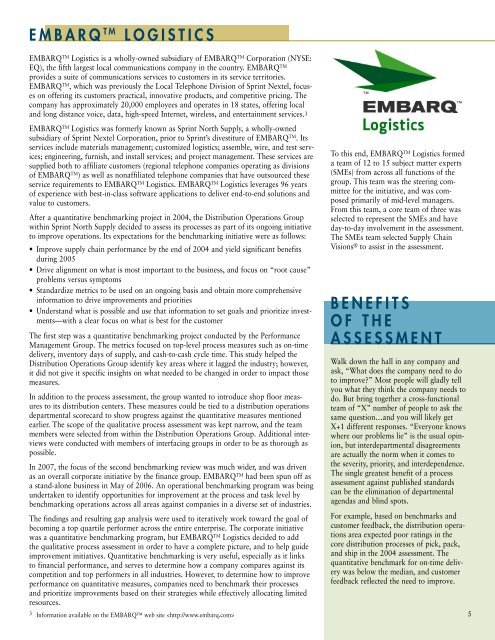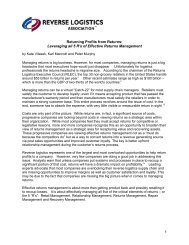PROCESS ASSESSMENT IN THE SUPPLY CHAIN: the eMBARQtM ...
PROCESS ASSESSMENT IN THE SUPPLY CHAIN: the eMBARQtM ...
PROCESS ASSESSMENT IN THE SUPPLY CHAIN: the eMBARQtM ...
You also want an ePaper? Increase the reach of your titles
YUMPU automatically turns print PDFs into web optimized ePapers that Google loves.
e m b A r Q t m l o g i s t i c s<br />
EMBARQ TM Logistics is a wholly-owned subsidiary of EMBARQ TM Corporation (NYSE:<br />
EQ), <strong>the</strong> fifth largest local communications company in <strong>the</strong> country. EMBARQ TM<br />
provides a suite of communications services to customers in its service territories.<br />
EMBARQ TM , which was previously <strong>the</strong> Local Telephone Division of Sprint Nextel, focuses<br />
on offering its customers practical, innovative products, and competitive pricing. The<br />
company has approximately 20,000 employees and operates in 18 states, offering local<br />
and long distance voice, data, high-speed Internet, wireless, and entertainment services.3<br />
EMBARQ TM Logistics was formerly known as Sprint North Supply, a wholly-owned<br />
subsidiary of Sprint Nextel Corporation, prior to Sprint’s divestiture of EMBARQ TM . Its<br />
services include materials management; customized logistics; assemble, wire, and test services;<br />
engineering, furnish, and install services; and project management. These services are<br />
supplied both to affiliate customers (regional telephone companies operating as divisions<br />
of EMBARQ TM ) as well as nonaffiliated telephone companies that have outsourced <strong>the</strong>se<br />
service requirements to EMBARQ TM Logistics. EMBARQ TM Logistics leverages 96 years<br />
of experience with best-in-class software applications to deliver end-to-end solutions and<br />
value to customers.<br />
After a quantitative benchmarking project in 2004, <strong>the</strong> Distribution Operations Group<br />
within Sprint North Supply decided to assess its processes as part of its ongoing initiative<br />
to improve operations. Its expectations for <strong>the</strong> benchmarking initiative were as follows:<br />
• Improve supply chain performance by <strong>the</strong> end of 2004 and yield significant benefits<br />
during 2005<br />
• Drive alignment on what is most important to <strong>the</strong> business, and focus on “root cause”<br />
problems versus symptoms<br />
• Standardize metrics to be used on an ongoing basis and obtain more comprehensive<br />
information to drive improvements and priorities<br />
• Understand what is possible and use that information to set goals and prioritize investments—with<br />
a clear focus on what is best for <strong>the</strong> customer<br />
The first step was a quantitative benchmarking project conducted by <strong>the</strong> Performance<br />
Management Group. The metrics focused on top-level process measures such as on-time<br />
delivery, inventory days of supply, and cash-to-cash cycle time. This study helped <strong>the</strong><br />
Distribution Operations Group identify key areas where it lagged <strong>the</strong> industry; however,<br />
it did not give it specific insights on what needed to be changed in order to impact those<br />
measures.<br />
In addition to <strong>the</strong> process assessment, <strong>the</strong> group wanted to introduce shop floor measures<br />
to its distribution centers. These measures could be tied to a distribution operations<br />
departmental scorecard to show progress against <strong>the</strong> quantitative measures mentioned<br />
earlier. The scope of <strong>the</strong> qualitative process assessment was kept narrow, and <strong>the</strong> team<br />
members were selected from within <strong>the</strong> Distribution Operations Group. Additional interviews<br />
were conducted with members of interfacing groups in order to be as thorough as<br />
possible.<br />
In 2007, <strong>the</strong> focus of <strong>the</strong> second benchmarking review was much wider, and was driven<br />
as an overall corporate initiative by <strong>the</strong> finance group. EMBARQ TM had been spun off as<br />
a stand-alone business in May of 2006. An operational benchmarking program was being<br />
undertaken to identify opportunities for improvement at <strong>the</strong> process and task level by<br />
benchmarking operations across all areas against companies in a diverse set of industries.<br />
The findings and resulting gap analysis were used to iteratively work toward <strong>the</strong> goal of<br />
becoming a top quartile performer across <strong>the</strong> entire enterprise. The corporate initiative<br />
was a quantitative benchmarking program, but EMBARQTM Logistics decided to add<br />
<strong>the</strong> qualitative process assessment in order to have a complete picture, and to help guide<br />
improvement initiatives. Quantitative benchmarking is very useful, especially as it links<br />
to financial performance, and serves to determine how a company compares against its<br />
competition and top performers in all industries. However, to determine how to improve<br />
performance on quantitative measures, companies need to benchmark <strong>the</strong>ir processes<br />
and prioritize improvements based on <strong>the</strong>ir strategies while effectively allocating limited<br />
resources.<br />
3 Information available on <strong>the</strong> EMBARQ web site <br />
To this end, EMBARQ TM Logistics formed<br />
a team of 12 to 15 subject matter experts<br />
(SMEs) from across all functions of <strong>the</strong><br />
group. This team was <strong>the</strong> steering committee<br />
for <strong>the</strong> initiative, and was composed<br />
primarily of mid-level managers.<br />
From this team, a core team of three was<br />
selected to represent <strong>the</strong> SMEs and have<br />
day-to-day involvement in <strong>the</strong> assessment.<br />
The SMEs team selected Supply Chain<br />
Visions ® to assist in <strong>the</strong> assessment.<br />
b e n e f i t s<br />
o f t h e<br />
A s s e s s m e n t<br />
Walk down <strong>the</strong> hall in any company and<br />
ask, “What does <strong>the</strong> company need to do<br />
to improve?” Most people will gladly tell<br />
you what <strong>the</strong>y think <strong>the</strong> company needs to<br />
do. But bring toge<strong>the</strong>r a cross-functional<br />
team of “X” number of people to ask <strong>the</strong><br />
same question…and you will likely get<br />
X+1 different responses. “Everyone knows<br />
where our problems lie” is <strong>the</strong> usual opinion,<br />
but interdepartmental disagreements<br />
are actually <strong>the</strong> norm when it comes to<br />
<strong>the</strong> severity, priority, and interdependence.<br />
The single greatest benefit of a process<br />
assessment against published standards<br />
can be <strong>the</strong> elimination of departmental<br />
agendas and blind spots.<br />
For example, based on benchmarks and<br />
customer feedback, <strong>the</strong> distribution operations<br />
area expected poor ratings in <strong>the</strong><br />
core distribution processes of pick, pack,<br />
and ship in <strong>the</strong> 2004 assessment. The<br />
quantitative benchmark for on-time delivery<br />
was below <strong>the</strong> median, and customer<br />
feedback reflected <strong>the</strong> need to improve.<br />
5




